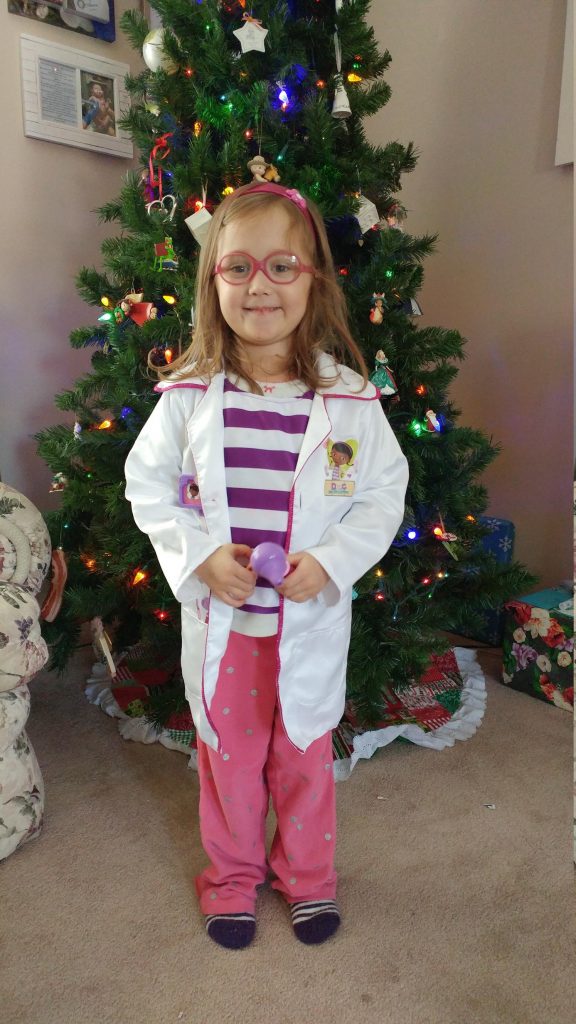Before I write about other topics I’ve alluded to in previous posts, I thought I’d provide a few updates on various happenings I’ve written about so far.
I’m happy to say that we found an open-mouth water bottle that seems to work for E. She had a small Minnie Mouse water bottle with an open mouth that I rediscovered after I wrote the post about drinking goals. I substituted it one day in place of her straw water bottles and she did very well with it. So, I decided to see if we could purchase another bottle like it for some variety. After looking around for a while, I decided on this Takeya one. It’s sturdy and easy enough for E to open, and I like that it’s a little smaller than her Bottled Joy bottles. I also really like the handle on it so she can carry it around. I ordered M some new water bottles too (she’d also bitten through all her straws), and in the process found the next one I’ll buy for E when one of hers needs replacing: it’s this Rubbermaid bottle. It seems like the best combination of both types of her current water bottles. And while my husband scratched his head a bit at new water bottles for both girls, I reminded him that these purchases will be well worth it. Drinking water all the time is E’s life, after all.
E loves to be outside during the summer and we don’t want her to miss out on key experiences of childhood. We keep her inside during the hottest parts of the day, but we also compensate for fluid lost through sweating by giving her extra fluid throughout the day. We aim for at least 100 mLs of extra fluid on top of her 1800 mL/day goal. When she’s running around and playing, drinking extra water is natural to her, just as it is to you and me. But when we need a fun summer treat, we make popsicles and smoothies. We usually make Koolaid popsicles in whichever color E and M decide they want. We have our own popsicle molds and I weigh the liquid in one section of the molds before we pop the full tray in the freezer. Last summer we started making smoothies at home in addition to the popsicles. M and I enjoy blueberry banana smoothies, but E LOVES cantaloupe smoothies! This summer melon smoothie recipe is our favorite, and she can’t wait until Grandpa has cantaloupes from his garden to share. I was not a big fan of fruit growing up (veggie lover here), so making smoothies at home is a big win for me on all fronts: I’m trying new fruit (mango was the new addition last week), my girls get healthy snacks, and E gets fluid for her fluid goal. We used our big blender last year to make all our smoothies, but in May my husband surprised me with an immersion blender. Ours is a Kitchen Aid 2-speed hand blender, and I love it! I can quickly wash the blending arm and set it out to dry and we can make smoothies again later in the day or right away the next day instead of waiting for all the pieces of our big blender to dry. The lid for the blender jar is very convenient as well. I’ve put the lid on and set leftover smoothie in the fridge for the next day and didn’t have to worry about dirtying any other glasses or cups. I know there are lots of different types of blenders out there for smoothie making, but I thought I’d share what is making my life a little easier. This week’s new smoothie ingredient is peaches, and next week’s is kiwi. As long as we stay away from grapefruit, we’ll be fine. As most of you transplant parents know, grapefruit doesn’t play nice with anti-rejection meds.
In March I wrote a post detailing our headaches with our insurance company denying coverage for two different injections E received in November. Well, I’m happy to report that 6 months later(!), we received word that those denials were officially overturned. As I mentioned, it took me, our nurse coordinator, and a financial coordinator to assemble records to submit to the insurance company to set matters straight and establish that the injections E received were medically necessary. Then one of E’s nephrologists had to get in contact with the insurance company’s doctor several times to explain why the injections were necessary. There’s got to be a better way for doctors to submit claims to insurance companies and for those doctors to submit evidence of medical necessity right away. The current system of denying coverage to the patient, informing the patient about the denial months later, and then asking the patient to assemble records and coordinate with doctors to submit evidence is such a long process. If doctors could submit reasons for treatments with their claims right away, then insurance companies would have all the information they need to take care of claims on their end and the process would go a lot smoother and more quickly, in my opinion.
E’s neutrophil counts have been up and down the last couple months, so we’re still riding things out to see if a medication change is needed. Unless her upcoming July labs are drastically low, I suspect we’ll discuss this topic in depth at E’s next routine check-up with her transplant team in August. To be honest, it makes me nervous watching those levels for a couple of reasons. The first obviously is that a low neutrophil count for E is dangerous, as I’ve already discussed. The second is that if a change in medication is necessary I hope we’ll be able to get that new med without complications from the pharmacy. I’m glad to say that I’ve only had one problem with CVS Specialty Pharmacy since January. This latest problem in May seems to be a problem with their automated system and customer service. I ordered one of E’s anti-rejection meds on a Saturday through her online patient portal and selected the day I wanted the medication delivered to our house, which was a Tuesday. We regularly get expedited two-day delivery. The system sent me a confirmation of the order that same day and I received a confirmation of shipment on Monday. On Tuesday I received a message stating that our delivery would be delayed until Wednesday. Then I received another message stating that the medication would be delayed indefinitely until I called the CVS customer care team. A delay in delivery is a problem because I have to make sure I am home to sign for the delivery and we were expected at appointments on that particular Wednesday. I called CVS to see what in the world was going on, and was told that my request was received too late in the morning on Saturday to get the medication to us by Tuesday. But I could create an account on the website of the commercial shipping company CVS uses, leave directions for the delivery driver if I wouldn’t be at home in time for delivery, and ask the driver stop at a different time. I was definitely annoyed at the cryptic messages from CVS and the explanation for the delay, but felt like I could deal with the solution just fine. But what I then learned from the shipping company’s website is that you cannot specify a change in directions for delivery if the package to be delivered is medication OR that package needs a signature. I can only give specific delivery directions to a driver if I’ve already missed one delivery. Frustrating. So, I ended up hurrying home from our Wednesday appointments and received E’s med when it arrived. I also told the CVS customer care rep how unhelpful the email messages about the delay were. I’m continuing to speak up about any problems we encounter with CVS.
In my post about pharmacies, I wrote about appreciating the little things in life like going to the pharmacy of your choice. Recently, I realized I find joy in another absurd little thing – finding brand-new unused syringes and medical supplies tucked away in cupboards in my house. 🙂 We still use syringes to give E all her meds through her G-button. She probably is old enough to take pills by mouth, but with her very sensitive gag reflex, we are content to keep giving meds this way for a few more years yet. Her G-button is a security blanket for all of us in that we can give her fluid boluses when she starts to get dehydrated, and we still routinely use it most days for one bolus. Having a button is so normal for E and she really owns it, so we don’t have problems there. The problems are making sure we have enough adults on hand to care for E that know how to use and change her button, and that we have enough supplies on hand for both her button and her meds. G-button kits like E has cost our insurance around $450 and we can only get one kit per quarter. So if E breaks a button, we have to have a spare on hand, go to the surgery clinic at the hospital for a new one, or order one and pay for it out-of-pocket. Thankfully, we’ve never had to order one out-of-cycle, and we’ve always had a spare on hand. We’ve also had great service from our home health companies for ordering the kits and supplies we need. Since the kits and supplies cost so much though, I try to only order exactly what we need. Therefore, it was awesome to find some spare med lines, bolus connectors, and bolus syringes tucked away in one of our cupboards at the beginning of the month. We regularly wash and reuse the lines, connectors, and tubes, so these spares were from previous kits where only the button had been used. When a line or tube gets to be worn out, we throw it away and replace it with a spare. So I did a happy dance when I realized we had more spares than I thought we did! The same goes for syringes. We use 8-9 syringes of various sizes each day for giving meds. That is much less than we used to use before and right after transplant, but it still amounts to quite a lot of syringes. (This is also one of the reasons why I spend more time washing dishes by hand than I would like.) We prefer to use Baxter Exactamed syringes, as they’re durable, fit all the bottle stoppers on E’s medication bottles, and have tight-fitting caps. But, those Baxter syringes are expensive. We’ve ordered packs of syringes several times, and then just wash and re-use the ones we have until we can no longer read the dosage lines on the syringes. So, imagine my delight when I found not one but two bags of brand new syringes stored away by my husband in different cupboards! Truly friends, it’s the little things in life that bring the most joy. And when you’re a Transplant Mom, you live for those little things!


